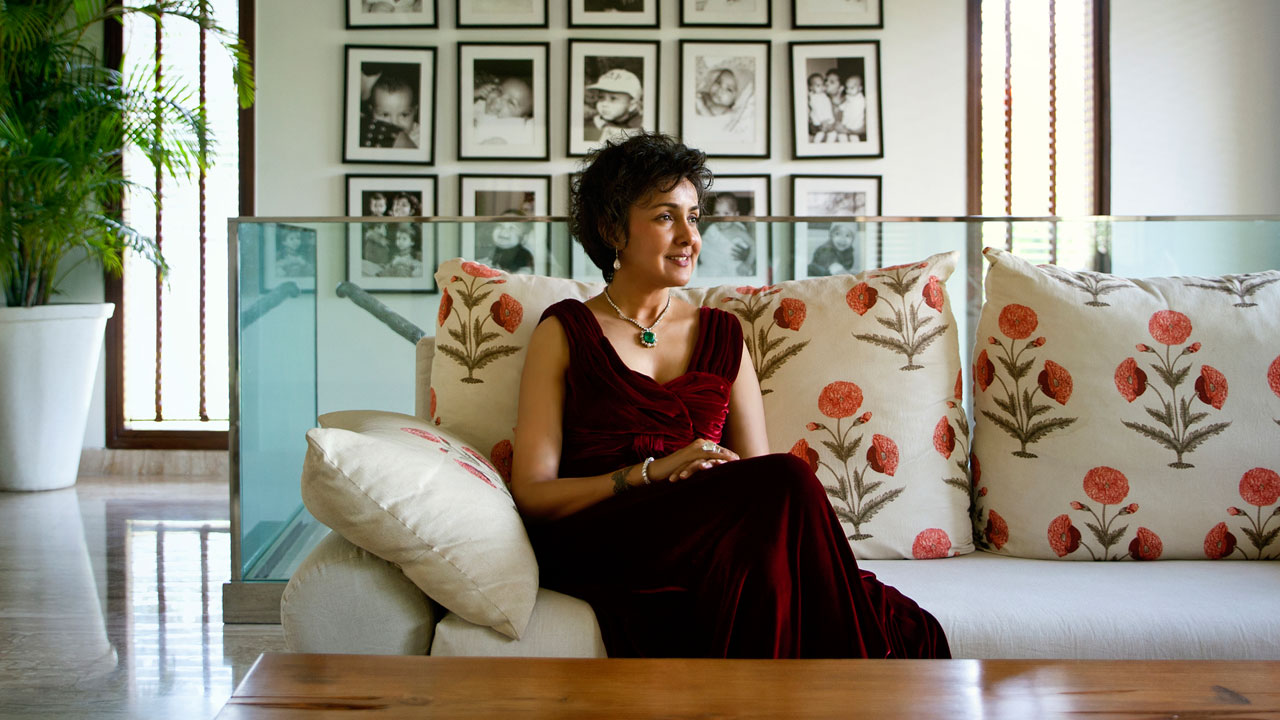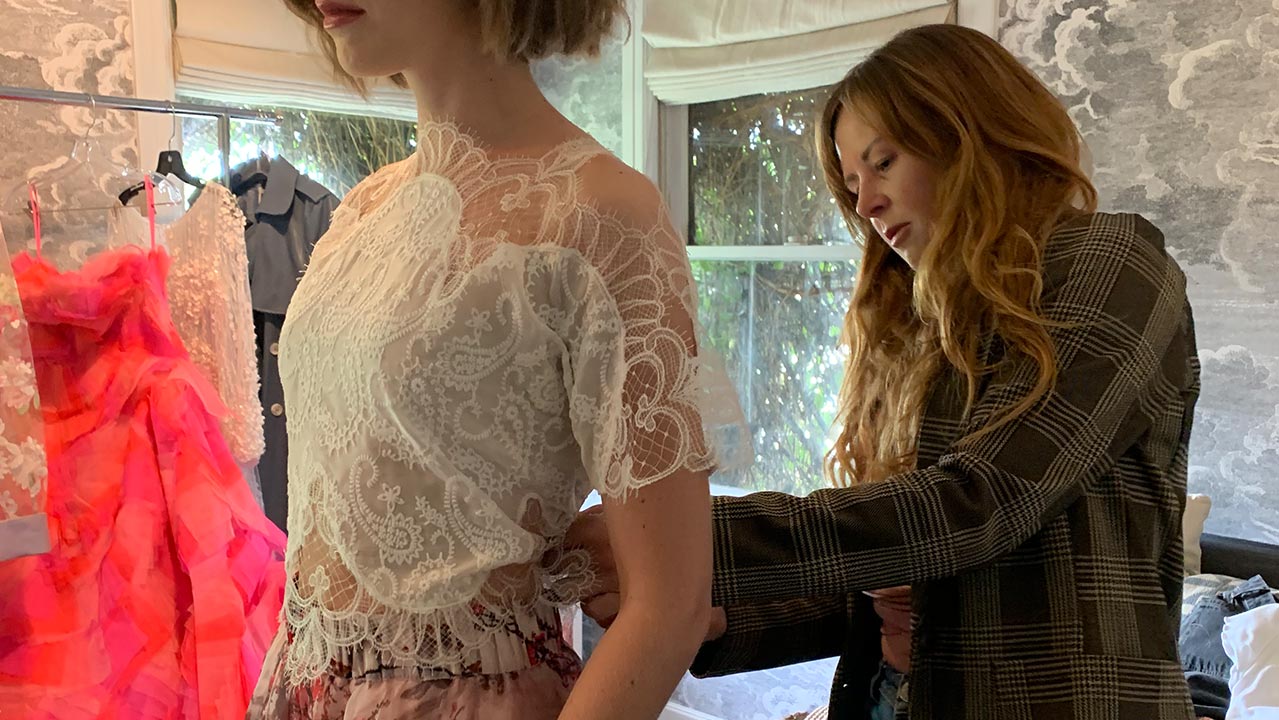
Alumni
Grad Payal Jain Showing at India Fashion Week
Indian fashion designer Payal Jain was born in the historic city of Delhi and had a childhood steeped in the creative arts. The daughter of a trained classical dancer and musician and a consultant who loved art and poetry, Payal said her sense of proportion, aesthetics, and design “all evolved from here, growing into a passion for art and architecture, and has continued to influence my design aesthetics.” She pursued a Business degree at Delhi University before her dream of studying Fashion Design became a reality at FIDM San Francisco. After graduating in 1993, she returned home to India where she became one of the country’s leading designers. We recently chatted with Payal — who will show at India Fashion Week this month — to learn more about her journey from International Student at FIDM to acclaimed couturier and ready-to-wear designer.
When did you first realize you wanted to study or work in fashion? Raised amidst art, culture, and music, I always knew I would be a part of the creative fields. Fashion designing encompasses all the aspects of creative arts, with a touch of realism, and I believe it was the perfect choice for me, one that I have grown to love and appreciate more and more with each passing day. While at high school, I was very keen on pursuing architecture as a profession, and one day a close friend of the family proposed Fashion Design as a career option and I leapt at the idea! Since my parents weren’t ready to send me away just yet, and I was only 16 at that time, I decided to pursue my undergraduate degree in Business at Delhi University. I went to Jesus and Mary College for a Bachelors in Commerce to learn the basics of economics, finance and accounting, which would help in my future in the fashion business.
Meanwhile, I began exploring the whole new world of fashion, and worked over the summer at a garment export unit, to get some basic understanding of the business. I also tried my hand at designing and sewing garments. Back then I knew nothing about sewing, so I took all the help I could from family and friends, bought fabrics, trims, buttons, zippers, et cetera and put together a small line of garments. My parents were kind enough to invite some of their friends to see the exhibit, and possibly out of kindness and courtesy, they bought everything I had made. I was over the moon. Once I had discovered my love for fashion and textiles there was no looking back.

What led you to attend FIDM San Francisco? While at college, my heart constantly yearned to pursue my true calling. Hence, I began studying about fashion schools in the U.S. There were no computers or Internet back in those days, and all communication happened through letters and by mail. I shortlisted a few fashion schools and programs that interested me and traveled with my father to visit the campuses during the summer break. I instantly fell in love with the San Francisco campus of FIDM and I hoped with all my heart that I would get an opportunity to study there. After a series of long, grueling telephonic interviews, and a final in-person interview, I finally got my much awaited admission and knew that I was on the path of fulfilling my dreams. I left for the States as soon as my undergraduate degree was completed and the rest is history.
What were some of the most valuable things you learned at FIDM? I believe there are aspects of both ‘art’ and ‘science’ to fashion. The ‘art’ of fashion is almost intrinsic to your personality and your creativity stems from it naturally, yet it needs direction, honing, and nurturing for expression. You cannot teach someone to be creative; you can only teach them mediums of expressing that creativity. The ‘science’ of fashion on the other hand needs to be learned and perfected; it includes technical skills, eye to detail, precision, and perfection. My years at FIDM were invaluable and taught me both the art and science of fashion, giving me an introduction to a whole new world. At FIDM, I learned all the technical skills I would need in my journey ahead, such as patternmaking, draping, grading, sketching, illustration, history of art, fashion marketing, visual merchandising, et cetera.
The program was tough and our instructors were people who gave us real hands-on advice, many of them juggling successful personal businesses alongside teaching at campus. This brought huge value to our knowledge and prepared us for what lay ahead of us. I learned the importance of precision; we were graded based on our accuracy, down to one-sixteenth and one-thirty-second of an inch. This taught me the commitment to perfection and its importance has stayed close to me through all my professional years. At FIDM, I learned that it is imperative for a designer to be hands-on with their skills and the only way to translate their vision into reality. You can see an idea from concept to completion if you know more than those working with you or for you, and find solutions to technical problems when they arise.
I also managed to do several internships during my program, spanning from a French couturier’s salon to an American kidswear brand and finally an intimate wear retail store. Each of these taught me things I would find most valuable in my own business. Amongst my special memories is a trip FIDM took us on to Europe, where we visited and met some of the biggest couture salons of the time, met the couturiers, and learned much through interactive sessions. Many years later, here I am showing at India Fashion Week alongside Lecoanet Hemant, one of the couture salons we visited on that memorable trip!

What were some of the challenges of starting your own business after returning to India? When I moved back in the early 1990s, fashion in India was just beginning to emerge. Designers were treated as glorified tailors and no one understood that there was a skill and education required to pursue a career in fashion. Today, designers have a huge fan following and are considered celebrities but, this journey has been long and hard. I started my studio in Hauz Khas Village, New Delhi under my label by creating outfits with ‘A western body and an Indian soul.’ In those days, most people were willing to spend thousands of dollars on Indian outfits, but refused to pay even 50 dollars for a well-tailored suit or immaculately draped dress. The scenario in those days was a far cry from fashion today, when almost every Indian woman wears pants, jeans, skirts, or dresses, and most prefer the practicality of Western wear over traditional ensembles, especially in the big cities.
Fashion in India has evolved beyond anyone’s imagination, and it is my absolute privilege to have been a part of this revolution. In addition to my personal involvement in the fashion industry, I am an active member of the Fashion Design Council of India, the official body of designers who are responsible for planning, curating, and installing India Fashion Week for the last 20 years. I have been an active member of the Board of FDCI for many years and have seen India Fashion Week go from 20 to 250 designer members, growing in strength with each passing year. Today, India Fashion Week figures on every International buyer’s calendar, and people from all parts of the world come to see our beautiful textiles and crafts, and fall in love with India.
What are the greatest joys of working as a top fashion designer? Fashion to me is a way of life. It is not only the clothes you wear but, also the destinations you travel to, the cuisine you enjoy, the furnishings you choose for your home, the wine you like to serve, the choice of art you collect and also the car you drive. It is all your unique and personal sense of style and fashion! My fashion label is an extension of my personality; I work with Indian textiles and crafts and have always been passionate about creating fabrics from scratch. My deepest joy lies in being able to see what I have envisioned come alive on a weaver’s loom or an embroiders’ ‘adda’. It takes a lot of time, patience, love, and passion to wait and watch each collection slowly take shape. The final result may never be visible to an onlooker, but the pleasure of creating it from a simple thought is absolutely unparalleled.
Fashion remains my first love, but over the years I have tried my hands at designing interiors, home furnishings, products, lifestyle, and corporate uniforms. My team and I have designed corporate fashion looks for over 200 hotels and corporates across the world, and each new project brings new challenges and much learning. Ever since I started my career, it has been my most important goal to uphold our heritage, and I work with craft and textile clusters across the country to drive this tradition forward. It is my sincere hope that Indian designers continue to work for the revival of our dying crafts, which we are blessed as Indians to have at our disposal. I have also written a book on Fashion Studies for high school students, which is meant to give an insight into the world of fashion and serve as a knowledge bank for students, who aspire to be designers.

What advice would you share with an aspiring designer? The single ‘mantra’ for success is passion and love for your work — to eat, sleep, breathe, dream, and love what you do with an intensity that cannot accommodate failure. There is no shortcut to hard work or success; it's a long and arduous journey and one that makes all hardships worthwhile, if you have faith in yourself and are willing to give it undivided passion, integrity, and commitment. Strong technical knowledge, ability to reinvent oneself each season, the ability to take all feedback in stride, faith and positivity, willpower, and resilience are attributes that will help you survive and succeed in the fashion business. The fashion industry is volatile, cruel, competitive, and ever-evolving. It's a long and tough road, but that single moment when you see your inspiration translated into a magnificent display of color, form, texture, sound, and light, is worth every single struggle and heartbreak.
Learn more at payaljain.com and on Instagram @payaljaindesign.
Categories: Fashion Design Alumni International




